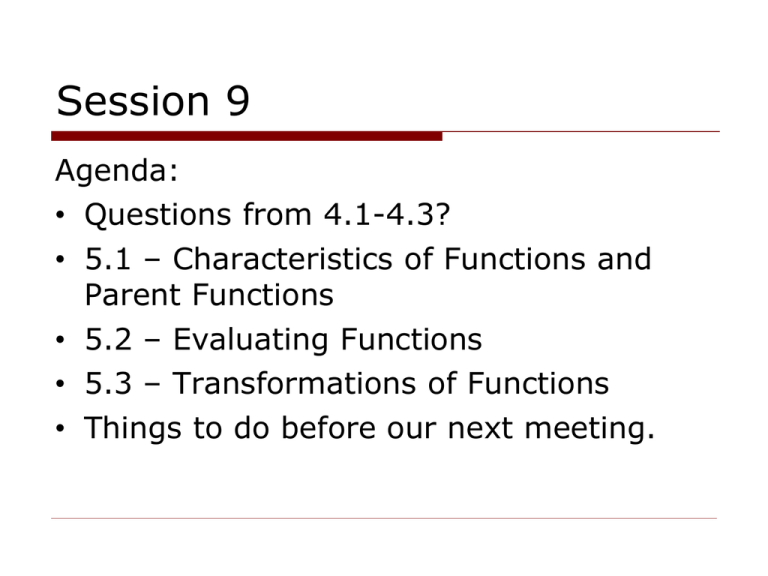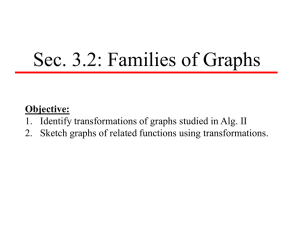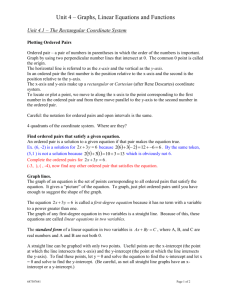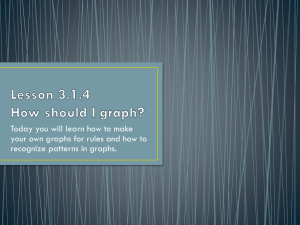Session 9
advertisement

Session 9
Agenda:
• Questions from 4.1-4.3?
• 5.1 – Characteristics of Functions and
Parent Functions
• 5.2 – Evaluating Functions
• 5.3 – Transformations of Functions
• Things to do before our next meeting.
Questions?
5.1 – Characteristics of Functions and
Parent Functions
• A function, f, is a rule that assigns to each value in a set
A a unique value in set B.
f
A B
• Set A is called the domain of the function.
• Set B is called the range of the function.
• In a function, no value in the domain can be assigned to
more than one value in the range.
• Function notation: We write f(a)=b, if the element a in
the domain is assigned to the element b in the range.
• Functions can be represented by sets of ordered pairs
where the first coordinates (x-values) are the elements in
the domain and the second coordinates (y-values) are
their corresponding elements in the range.
• For example, consider the set of ordered pairs
{(1,1), (2,7), (3,7), (5,9)}. Does this set of ordered
pairs represent a function? If not, why not? If so, what
are the domain and range of the function?
• Using function notation, we would write
f(1)=1, f(2)=7, f(3)=7, and f(5)=9.
• Consider the set of ordered pairs
{(1,4), (3,7), (4,8), (1,9), (2,12)}. Does this set
represent a function? If not, why not? If so, what are the
domain and range of the function?
• Most of the time when dealing with functions, instead of
listing ordered pairs, we express the function in terms of
the rule that assigns the domain values to the range
values. For example:
f ( x) x2 5, g ( x) x 4, h( x) ( x 7)3
are all examples of functions.
• The domain is the set of all x-values for which the
function is defined.
• The range is the set of all values of f(x) that are attained.
These are the y-values.
• All the points (x, f(x)) for which the function is defined
form the graph of the function in the coordinate plane.
• Given a graph, use the Vertical Line Test to determine if
the graph represents a function:
A graph represents a function if no vertical line intersects
the graph at more than one point.
• Determine whether each of the following graphs represent
functions or not.
Given the following graphs of functions, determine the
domain and range from the graph.
• The x-intercepts of a graph are the points where the
graph touches or crosses the x-axis.
• The y-intercept of a graph is the point where the graph
touches or crosses the y-axis.
• Note that it is possible for graphs to not have
x-intercepts or a y-intercept.
• Determine the x and y-intercepts of the graphs on the
previous slide.
•
A function is said to be increasing on an interval if f(a)<f(b)
whenever a<b on the interval. In other words, as x increases,
so does y. This means the graph is rising from left to right.
•
A function is said to be decreasing on an interval if f(a)>f(b)
whenever a<b on the interval. In other words, as x increases, y
decreases. This means the graph is falling from left to right.
•
A function is said to be constant on an interval if f(a)=f(b) for
any a and b on that interval.
•
A function has a maximum value if the function has a point
(a, f(a)), where f(a)≥f(x) for all x in the domain.
•
A function has a minimum value if the function has a point
(a, f(a)), where f(a)≤f(x) for all x in the domain.
Determine the intervals where the following functions are
increasing, decreasing, and/or constant. Determine the
maximum and minimum values of the function if they exist.
• To determine if an equation represents a function
(without using a graph), try to solve the equation for y.
If it is possible to solve for y uniquely, then the equation
represents a function.
• Determine if the following equations represent functions.
x2 y3 x4
y 2 ( x2 2)3
y 3x 10
It is important to be able to recognize and graph the basic
parent functions that are used often in mathematics. Make
sure you are comfortable with the graphs below.
f ( x) x
f ( x) x3
f ( x) x2
f ( x) x
f ( x) 3 x
4
f ( x) x
1
f ( x) 2
x
f ( x) x
1
f ( x)
x
5.2 – Evaluating Functions
• Evaluating functions involves determining the function
value (y-value) for a given x-value in the domain.
• Given the function f ( x) x2 7 x 3 , evaluate the following.
f (2)
f ( 2)
f ( x2 )
f (4 a )
2 f ( x)
f (3 h)
• For the same function below, find and simplify
f ( x) x2 7 x 3
f (3 h) f (3)
h
• For the function below, find and simplify
f ( x)
2
x7
f ( x ) f (1)
x 1
• The difference quotient for a function f(x) is:
f ( x h) f ( x)
h
• Find and simplify the difference quotient for the function
f ( x) 3x 2
• Find and simplify the difference quotient for the function
g ( x)
x 1
x2
5.3 – Transformations of Functions
• Vertical Shifts
– Given the graph of f(x), the graph of f(x)+c, c>0, is
obtained by shifting the graph of f(x) UP c units.
– Given the graph of f(x), the graph of f(x)-c, c>0, is obtained
by shifting the graph of f(x) DOWN c units.
• Horizontal Shifts
– Given the graph of f(x), the graph of f(x+c), c>0, is
obtained by shifting the graph of f(x) c units to the LEFT.
– Given the graph of f(x), the graph of f(x-c), c>0, is obtained
by shifting the graph of f(x) c units to the RIGHT.
Identify the parent function and describe how the following
graphs would be obtained from the graph of the parent
function. Sketch a graph of the function.
f ( x) 3 x 4 6
g ( x) ( x 4)3 2
• Vertical Scaling (Stretching/Shrinking)
– Given the graph of f(x), the graph of cf(x), for c > 1, is
found by vertically stretching the graph of f(x) by a factor of
c.
– Given the graph of f(x), the graph of cf(x), for 0 < c < 1, is
found by vertically shrinking (or compressing) the graph of
f(x) by a factor of c.
• Reflections
– Given the graph of f(x), the graph of –f(x) is found by
reflecting the graph of f(x) about the x-axis.
– Given the graph of f(x), the graph of f(-x) is found by
reflecting the graph of f(x) about the y-axis.
Identify the parent function and describe how the following
graphs would be obtained from the graph of the parent
function. Sketch a graph of the function.
f ( x) 3 x
h( x )
1
x
2
Sketch a graph of the following function using
transformations.
f ( x) 2( x 1)2 5
•
Given the graph of f(x) below, sketch a graph of
1
f ( x 2) 3
2
• The graph of f(x)=1/x is shifted to the right 5, reflected
about the y-axis, shrunk by a factor of ⅛, shifted down 4
units, and then reflected across the x-axis. Write the
function rule for the resulting graph.
Things to Do Before Next Meeting:
• Work on Sections 5.1-5.3 until you get all green
bars!
• Write down any questions you have.
• Continue working on mastering 4.1-4.3. After
you have all green bars on 4.1-4.3, retake the
Chapter 4 Test until you obtain at least 80%.











